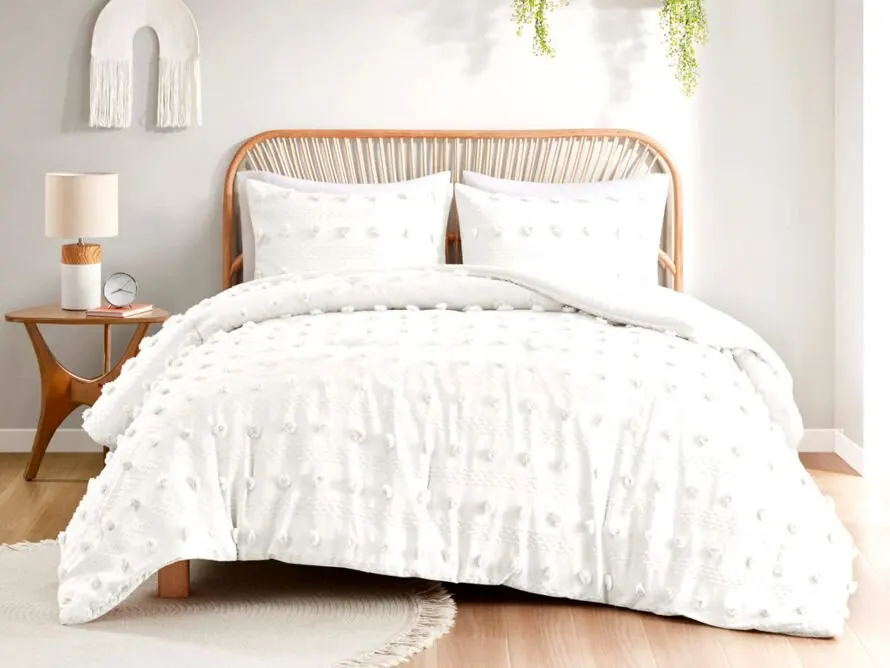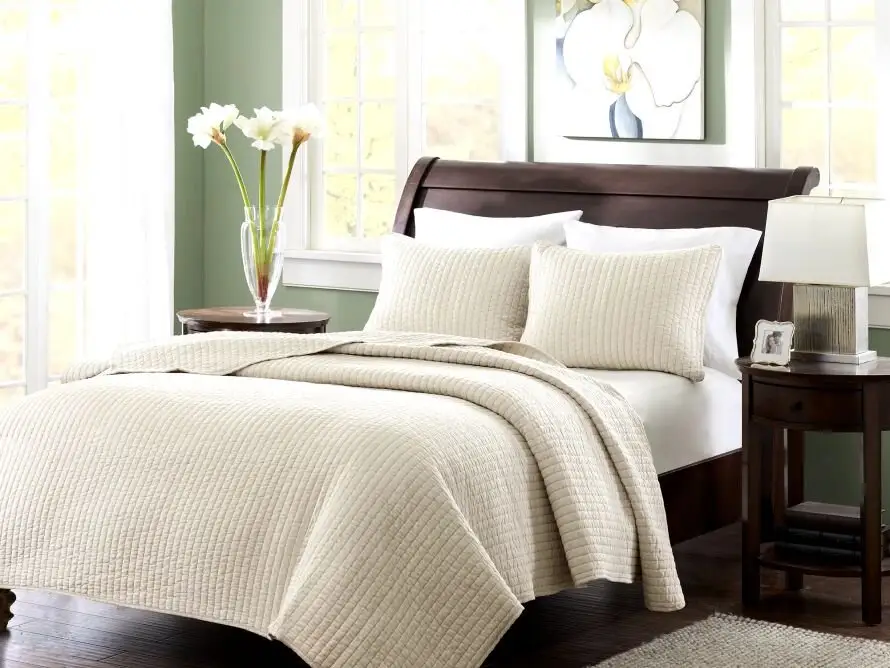You're on the list
By signing up, you agree to receive email marketing.


Alongside pillows and sheets, the comforter you choose factors heavily into your bed’s coziness factor. Your primary concern may be warmth. But you’ll find that the best comforters offer the right balance of weight, texture, and breathability.
There are an overwhelming number of options to choose from, so this article will dig deep into the essentials of how to choose a comforter, hunting down the perfect duvet, a coverlet vs quilt, how to choose a down comforter, and more.
Comforters, like any piece of bedding, have a lifespan. A good-quality comforter can last anywhere from five to 10 years, depending on how often it's used and how well it's cared for. If you regularly wash the comforter and use a duvet cover you’ll extend its life even further.
Does it seem like your comforter is losing its warmth, becoming lumpy, or has a persistent odor even after cleaning? You guessed it — it’s probably time for a replacement.
Step one is to understand the difference between a comforter and a duvet insert. A comforter is a thick, quilted blanket filled with insulating materials like down, feathers, or synthetic fibers. It's usually decorative and doesn't require a cover, although you can add one if you like.
A duvet insert is placed inside a duvet cover. This two-piece system allows for easy cleaning and style changes. The duvet cover protects the insert and can be changed more frequently. This is why it’s an intuitive option for those who like to frequently switch up their bedroom decor.
There is no bad option. Your choice will come down to what you prioritize when it comes to sleep comfort, what climate you live in, how long you want to commit to the bedding, and more.
Comforters are versatile, easy to maintain, and come in various styles and thicknesses. Quilts are lighter and ideal for warmer climates or as a layering piece.
Don’t confuse quilts and coverlets. A coverlet is a lightweight, non-reversible bedspread that typically covers the top of the bed and hangs slightly over the sides. However, a coverlet is thinner than a quilt.
Duvets offer the convenience of easy cleaning and customization via different covers. Choose from the types of comforters to find one that resonates with you.


Comforters come in a wide range of prices that depend on the materials and brand. If you establish a budget beforehand, it will narrow down your options and may prevent you from overspending. Remember, a higher price doesn't always mean better quality, so you’ll have to look further than the price tag to find the right balance between cost and comfort.
Your local climate should play a significant role in choosing the right comforter. For colder climates, look for a heavier comforter with down or synthetic fill that provides excellent insulation. In warmer areas, a lightweight, breathable comforter made from cotton or bamboo will keep you comfortable without overheating.
The materials used in your comforter will determine its comfort, warmth, and durability. High-quality natural materials like down or wool provide excellent insulation and breathability, making them ideal for colder climates. On the other hand, synthetic materials such as polyester are often more affordable and easier to maintain. The choice of fabric for the outer shell also plays a crucial role in the overall feel and longevity of the comforter
The outer fabric, or the "shell," is hugely important because it determines the comforter's feel and breathability. Two of the most popular options are cotton and microfiber. Cotton provides softness and breathability. Microfiber is soft, durable, and often more affordable.
If you’re in the market for a more luxurious feel, consider silk or a high thread-count cotton sateen.
The fill material inside your comforter determines the warmth and weight of the bedding. You’ll probably come across these options:
— Down is light, fluffy, and excellent at trapping heat which is ideal for colder climates.
— Bamboo is a good, breathable choice for those seeking an ultra-soft, natural fabric.
— Cotton is airy and lightweight. You should consider it if you live in a warm area. It’s notably easy to care for.
— Wool is a natural insulator and can keep you warm without overheating.
Comforters come in all standard bed sizes, including twin, full/queen, and king. This might be the easiest decision you make: What size is your bed? If you want your comforter to drape over the sides, buy a size up. If you want it to just cover the top, stay true to your bed’s size. If you're unsure or between sizes, go up a size for a fuller look.
If you look closely at a comforter, you’ll notice that the stitching pattern can be quite beautiful. Did you know that stitching also affects its durability and evenness of fill distribution? Here are some common stitching patterns:
Choose a comforter whose patterns and colors complement your bedroom decor. You’ll likely be able to find any design you could possibly imagine — solid colors, subtle patterns, bold prints, and more. Take into consideration the overall look and feel of your space to make sure your new comforter fits in (or stands out) perfectly.
You’re all set to start shopping. Focus on what matters most to you in bedding, and you’ll end up with a comforter that you’re eager to wrap yourself up in each night. We wish you good luck and cozy sleeping!
You're on the list
By signing up, you agree to receive email marketing.